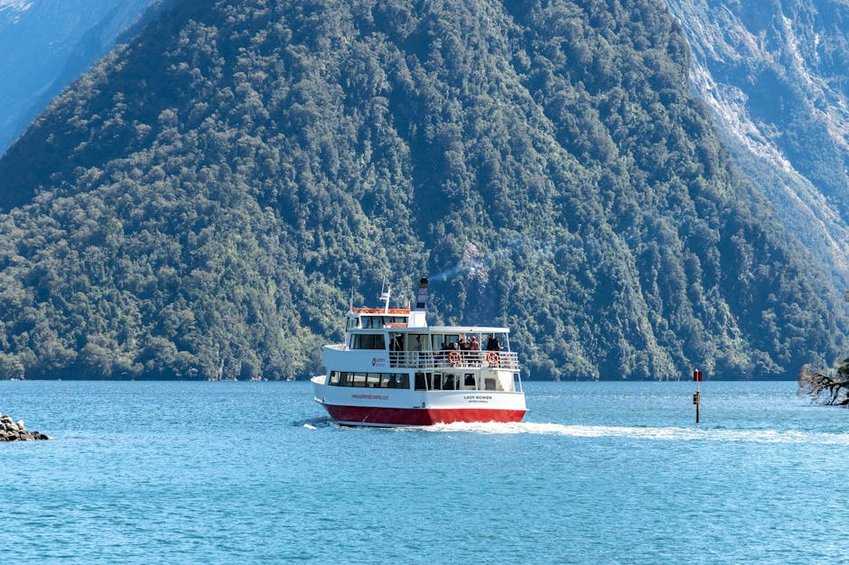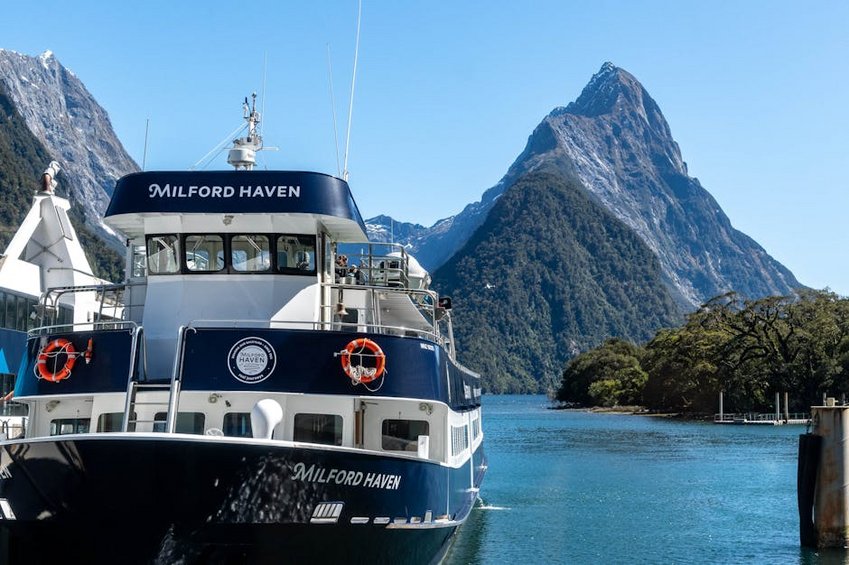New Zealand Milford Sound: The Ultimate Travel Guide to Fiordland’s Crown Jewel
Imagine sailing through towering granite cliffs that rise dramatically from dark, reflective waters, with countless waterfalls cascading down their misty faces. This is New Zealand Milford Sound, one of the most breathtaking natural wonders you’ll ever experience. Nestled within the UNESCO World Heritage-listed Fiordland National Park on New Zealand’s South Island, this magnificent fiord (technically a fiord, not a sound) captivates every visitor with its raw, untouched beauty. Whether you’re arriving by scenic drive, flight, or as part of a longer hiking adventure, New Zealand Milford Sound delivers an awe-inspiring experience that stays with you long after you’ve returned home. The combination of majestic Mitre Peak, playful dolphin pods, and the thunderous roar of Stirling Falls creates a symphony of natural wonders that makes this destination truly unforgettable for any traveler seeking nature’s grandest performances.
New Zealand Milford Sound Essential Information – What Makes It Special
New Zealand Milford Sound represents the spectacular culmination of glacial activity over thousands of years, creating a landscape so dramatic it feels almost otherworldly. The fiord stretches 15 kilometers inland from the Tasman Sea, with peaks soaring up to 1,692 meters directly from the water’s edge. What makes this place particularly magical is its weather patterns – the region receives over 6 meters of rainfall annually, which translates into hundreds of temporary waterfalls that appear during and after rain showers, complementing the two permanent falls (Stirling and Bowen Falls). The marine environment is equally impressive, with black coral trees thriving in the unique tannin-darkened waters and a diverse array of wildlife including fur seals, penguins, and bottlenose dolphins. This combination of geological grandeur and rich ecosystems creates an experience that feels both ancient and vibrantly alive.
Geological Formation and Significance – What You Need to Know
- Carved by glaciers during successive ice ages over millions of years, with the steep cliffs showing clear glacial scarring
- Unique hydrological system where freshwater sits atop saltwater due to tannins from rainforest vegetation, creating a rare marine environment
- Part of Te Wahipounamu Southwest New Zealand World Heritage Area, recognized for its outstanding natural values and geological significance
- Budget traveler: $150-250 USD per person for a day trip from Queenstown including coach transport and basic cruise, self-provided meals
- Mid-range experience: $300-500 USD per person including scenic flight option, premium cruise with lunch, and perhaps one night accommodation
- Luxury adventure: $600-1000+ USD per person including helicopter flight, overnight cruise experience, gourmet dining, and guided kayaking
- New Zealand Department of Conservation – Milford Sound/Piopiotahi
- Earth Trekkers Comprehensive Milford Sound Guide
Wildlife Encounters – Key Details
One of the most delightful aspects of visiting New Zealand Milford Sound is the frequent wildlife sightings that occur throughout your journey. The fiord’s nutrient-rich waters support a diverse marine ecosystem, making wildlife encounters almost guaranteed during your cruise. You’ll likely spot New Zealand fur seals basking on the rocks near Seal Point, particularly on the underwater rocks that rise near the entrance to the fiord. If you’re fortunate, you might encounter pods of bottlenose dolphins that often play in the wake of boats, sometimes swimming alongside vessels for several minutes. During certain seasons, you may even glimpse Fiordland crested penguins, one of the rarest penguin species in the world, though these shy creatures are more often seen during the quieter early morning or late afternoon cruises.

New Zealand Milford Sound Planning Your Trip – Seasons, Budget, and Preparation
Planning your visit to New Zealand Milford Sound requires careful consideration of seasons, transportation options, and necessary preparations to ensure you have the best possible experience. The remote location means weather can change rapidly, and access involves either a significant drive or flight into the area. During peak season (December-February), you’ll need to book accommodations and cruises well in advance, as this is both summer in New Zealand and the busiest tourist period. Shoulder seasons (spring and autumn) often provide a excellent balance of decent weather and smaller crowds, while winter visits offer a completely different experience with snow-capped peaks and potentially challenging road conditions. No matter when you visit, packing layers, waterproof clothing, and being flexible with your plans will serve you well in this dynamic environment.
Best Time to Visit New Zealand Milford Sound
The best time to visit New Zealand Milford Sound depends largely on what experience you’re seeking and your tolerance for rainfall. Summer (December-February) offers the warmest temperatures (average 17-20°C/63-68°F) and longest daylight hours, but also brings the largest crowds. Autumn (March-May) provides stunning foliage colors in the surrounding forests and generally stable weather conditions, while winter (June-August) transforms the landscape into a snow-dusted wonderland with spectacular views of snow-capped peaks. Spring (September-November) brings blooming native flowers and rushing waterfalls from melting snow. Ironically, rainy days often provide the most dramatic experience with countless temporary waterfalls cascading down the cliffs, so don’t be discouraged by forecasted precipitation – some of my most memorable visits have been during light rain showers.
Budget Planning and Costs
Essential Preparation Checklist
Preparing properly for your New Zealand Milford Sound adventure will significantly enhance your experience in this remote wilderness area. First and always pack waterproof clothing – even on sunny days, the spray from waterfalls during cruises can leave you drenched without proper gear. Comfortable walking shoes are essential for exploring the Milford Sound waterfront and nearby short walks. Don’t forget your camera with extra memory cards and batteries, as you’ll be taking hundreds of photos of the stunning scenery. If you’re driving yourself, ensure your vehicle has a full tank of gas as there are no services along the Milford Road until you reach the sound. Finally, bring motion sickness medication if you’re prone to seasickness, as the waters in the sound can sometimes be choppy, especially when crossing the entrance to the Tasman Sea.
New Zealand Milford Sound Top Attractions and Activities – Beyond the Classic Cruise
While the iconic cruise experience remains the centerpiece of any visit to New Zealand Milford Sound, the area offers numerous other activities that allow you to experience this magnificent landscape from different perspectives. Kayaking provides an intimate, water-level view of the fiord’s grandeur, allowing you to hear the waterfalls’ thunderous roar and perhaps get close enough to feel their mist on your face. Several spectacular walking tracks ranging from 15-minute strolls to multi-day adventures offer terrestrial viewpoints of the sound and surrounding mountains. For the ultimate perspective, scenic flights provide a breathtaking aerial overview of the entire fiord system within Fiordland National Park. Each activity offers a unique way to connect with this ancient landscape, and combining several approaches will give you the most comprehensive experience of New Zealand Milford Sound’s diverse beauty.
Must-See Highlights and Viewpoints
No visit to New Zealand Milford Sound is complete without experiencing its iconic landmarks from both water and land perspectives. Mitre Peak stands as the most photographed feature, rising an impressive 1,692 meters directly from the water’s edge – for the best photographs, try to capture it during the golden hours of early morning or late afternoon when the light accentuates its dramatic form. Stirling Falls plunges 155 meters into the sound, and cruise boats typically approach close enough that adventurous passengers can stand on the bow and feel the powerful spray. Bowen Falls, at 162 meters, serves as the primary water source for the Milford Sound settlement and creates a beautiful backdrop to the wharf area. On land, the Foreshore Walk provides accessible viewpoints of the sound and surrounding peaks, while more ambitious hikers can tackle portions of the world-famous Milford Track which begins nearby.
Hidden Gems and Local Favorites
Beyond the well-trodden tourist path, New Zealand Milford Sound holds several lesser-known treasures that offer more intimate experiences with this spectacular environment. The underwater observatory provides a fascinating glimpse beneath the surface of the dark waters, where you can see black coral trees thriving much shallower than usual due to the unique light-filtering properties of the freshwater layer. Harrison Cove offers a more sheltered area where kayakers often spot marine life more reliably than in the main channel. For those staying overnight, the sound transforms after day-trippers depart, offering incredible stargazing opportunities in some of the darkest skies in New Zealand. The quiet hours of early morning before the first cruises depart provide magical moments of solitude with just the sound of waterfalls and bird calls echoing off the granite walls.
New Zealand Milford Sound Practical Travel Information – Transportation and Accommodation
Navigating the practical aspects of visiting New Zealand Milford Sound requires understanding the limited infrastructure in this remote wilderness area. The sound sits approximately 4-5 hours drive from Queenstown and 2-3 hours from Te Anau, the two main gateway towns for visitors. There are no towns or settlements at Milford Sound itself – only a small terminal building with basic facilities, a café, and the Milford Sound Lodge. This remoteness means you must plan your transportation carefully, whether driving yourself, taking a coach tour, or flying in. Accommodation options are extremely limited, with only one lodge actually at the sound, making advance booking essential for overnight stays. Despite these challenges, the journey to New Zealand Milford Sound through spectacular alpine scenery becomes part of the adventure itself, building anticipation for the magnificent destination that awaits.
| Transportation Method | Details and Experience | Price Range (USD) |
|---|---|---|
| Self-Drive | Freedom to stop along Milford Road, requires booking cruise separately, mountain driving experience needed | $50-100 (fuel) + cruise costs |
| Coach Tour | Includes commentary, often combined with cruise, no parking worries, fixed schedule | $120-200 per person |
| Scenic Flight | Breathtaking aerial views, time-efficient, weather-dependent, often includes cruise | $300-500 per person |
| Overnight Cruise | Most immersive experience, includes meals, wildlife spotting opportunities, limited availability | $400-800 per person |


